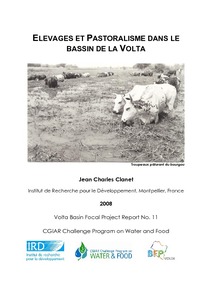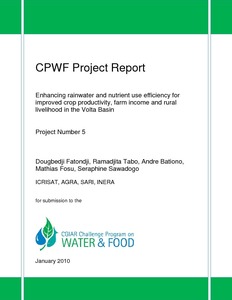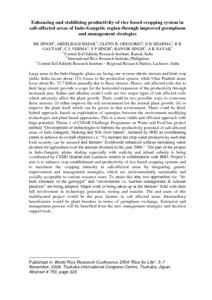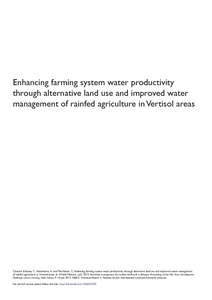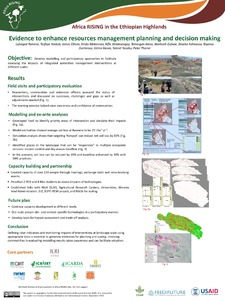El ambiente socio-economico de la produccion de raices y tuberculos: implicaciones para el diagnostico
Using the farm as unit of analysis, diagnosis processes aimed at improving production systems are reviewed. Within a country, diagnosis should be conducted at different hierarchical levels: local (interaction between the production system and the input distribution sector, the marketing sector, possible forms of processing, and consumption characteristics); regional (appropriate selection of target site); and national (development trends and governmental policies at the macroeconomic and sectorial levels).
Enhancing rainwater and nutrient use efficiency for improved crop productivity, farm income and rural livelihood in the Volta Basin
Enhancing and stabilizing productivity of rice-based cropping system in salt-affected areas of Indo-Gangetic region through improved germplasm and management strategies
Enhancing farming system water productivity through alternative land use and improved water management of rainfed agriculture in Vertisol areas
Waterlogged Vertisols are amongst the high potential soils where management interventions could result in positive impacts. This study utilized soil, climate and crop and livestock productivity data and models to demonstrate intensification strategies which increase crop–livestock system productivity and to understand the effects of alternative land use and water management options on water productivity in the Vertisols areas.
Evaluation of the use of fresh water by four Egyptian farms applying integrated aquaculture – agriculture
Evidence to enhance resources management planning and decision making
Evidence-based scaling-up of evergreen agriculture for increasing crop productivity, fodder supply and resilience of the maize-mixed and agro-pastoral farming systems in Tanzania and Malawi
Evidence-based Scaling-up of Evergreen Agriculture for Increasing Crop Productivity, Fodder Supply and Resilience of the maize-mixed and agropastoral farming systems in Tanzania and Malawi Interim technical report July 2012
Experiences from stakeholder dialogues in Tamale, northern Ghana
Tamale is the capital city of Ghana’s Northern Region. As the regional capital, Tamale is growing rapidly – the population has almost tripled to over 370,000 in the past 30 years, and the areal extent has increased up to sevenfold in the same period. Urban agriculture is an integral part of the food system, linked to resource management and spatial planning. In general one can say that backyard farming flourishes, but more formally organised production is threatened by urbanisation.
Extent and implications of incorrect offspring-sire relationships in pastoral production system in Kajiado District, Kenya
The aim of this study was to evaluate accuracy of farmer's paternity identification which determines success of future breed selection and hence genetic gain. Paternity of 269 Orma/zebu and Sahiwal/zebu calves was evaluated using genetic markers and the likelihood based method. Results indicate that only 6.7% farmer alleged paternities were confirmed, 88% parent-offspring relationships were rejected and 18% parent-offspring relationships were undetermined. However, 82% of offsprings were assigned at least 80% confident paternities to one of the sampled candidate males.



